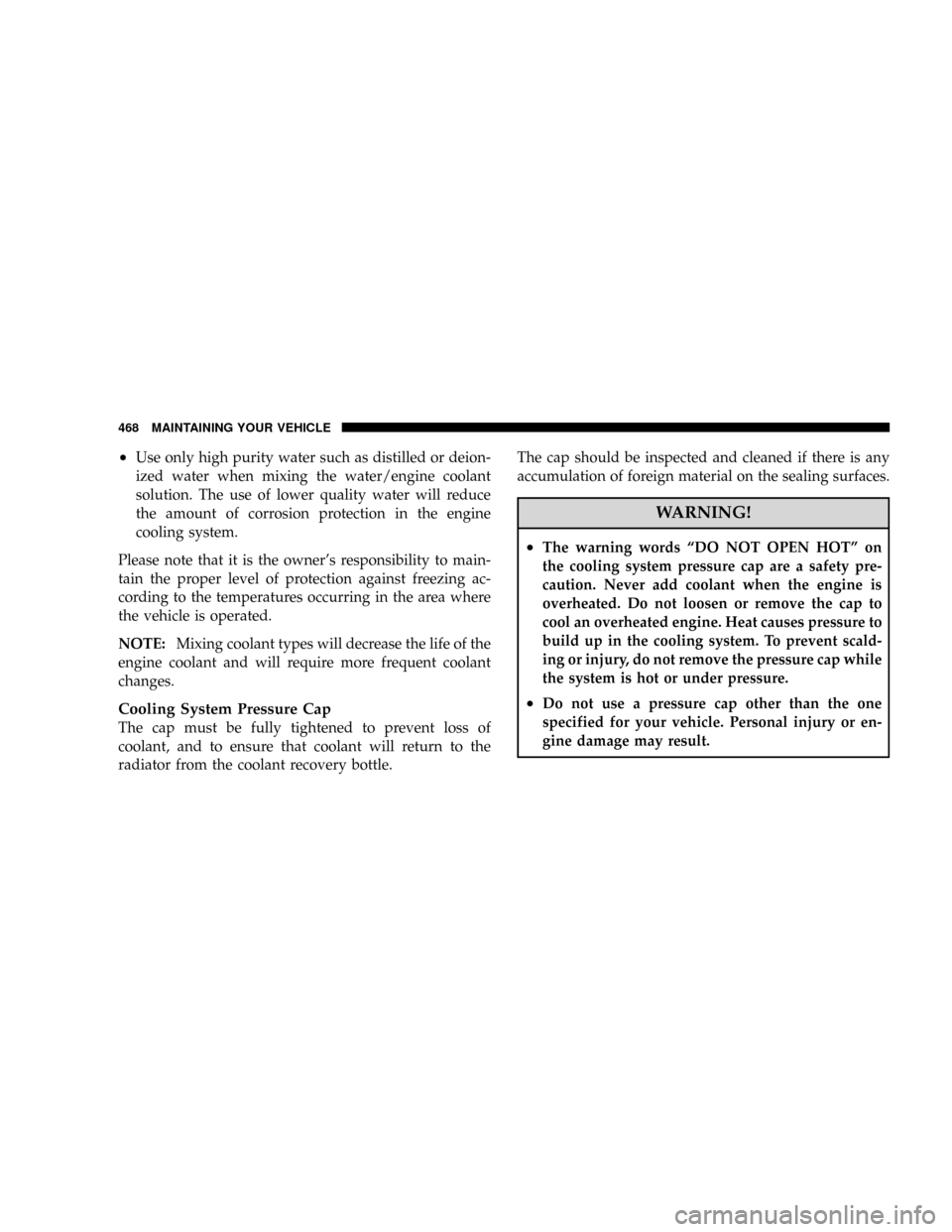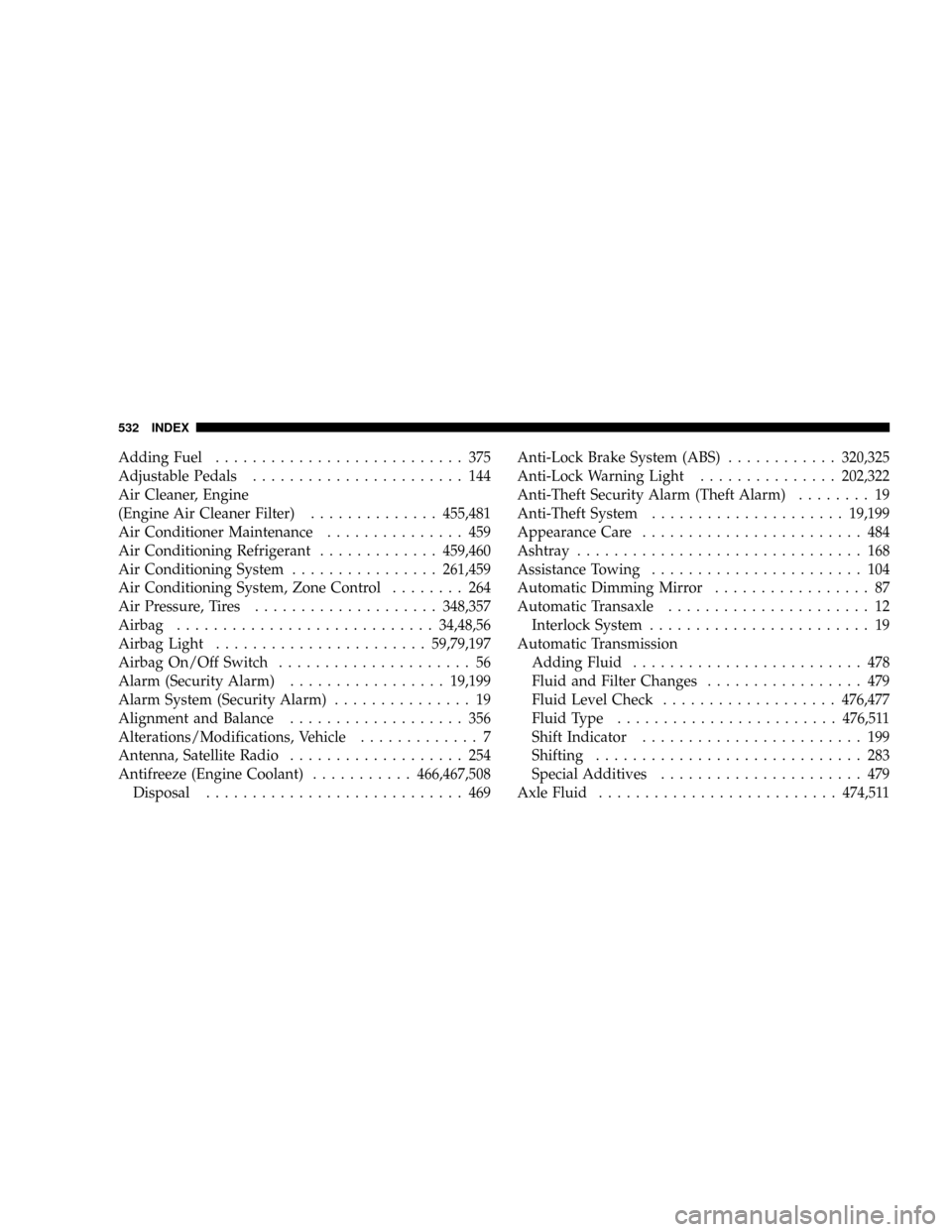2008 DODGE RAM 3500 GAS coolant level
[x] Cancel search: coolant levelPage 288 of 554

²the engine coolant has reached normal operating tem-
perature;
²vehicle speed is above approximately 30 mph (48
km/h);
²the ªTOW HAUL O/D OFFº switch has not been
activated;
²transmission has reached normal operating tempera-
ture.
NOTE:If the vehicle is started in extremely cold tem-
peratures, the transmission may not shift into Overdrive
and will automatically select the most desirable gear for
operation at this temperature. Normal operation will
resume when the transmission fluid temperature has
risen to a suitable level. Refer also to the Note under
torque converter clutch, later in this section.If the transmission temperature gets extremely hot, the
transmission will automatically select the most desirable
gear for operation at this temperature. If the transmission
temperature becomes hot enough the TRANS TEMP light
may illuminate and the transmission may downshift out
of Overdrive until the transmission cools down. After
cooldown, the transmission will resume normal opera-
tion.
The transmission will downshift from Overdrive to Drive
if the accelerator pedal is fully depressed at vehicle
speeds above approximately 35 mph (56 km/h).
286 STARTING AND OPERATING
Page 470 of 554

²Use only high purity water such as distilled or deion-
ized water when mixing the water/engine coolant
solution. The use of lower quality water will reduce
the amount of corrosion protection in the engine
cooling system.
Please note that it is the owner's responsibility to main-
tain the proper level of protection against freezing ac-
cording to the temperatures occurring in the area where
the vehicle is operated.
NOTE:Mixing coolant types will decrease the life of the
engine coolant and will require more frequent coolant
changes.
Cooling System Pressure Cap
The cap must be fully tightened to prevent loss of
coolant, and to ensure that coolant will return to the
radiator from the coolant recovery bottle.The cap should be inspected and cleaned if there is any
accumulation of foreign material on the sealing surfaces.
WARNING!
²The warning words ªDO NOT OPEN HOTº on
the cooling system pressure cap are a safety pre-
caution. Never add coolant when the engine is
overheated. Do not loosen or remove the cap to
cool an overheated engine. Heat causes pressure to
build up in the cooling system. To prevent scald-
ing or injury, do not remove the pressure cap while
the system is hot or under pressure.
²Do not use a pressure cap other than the one
specified for your vehicle. Personal injury or en-
gine damage may result.
468 MAINTAINING YOUR VEHICLE
Page 471 of 554

Disposal of Used Engine Coolant
Used ethylene glycol-based engine coolant is a regulated
substance requiring proper disposal. Check with your
local authorities to determine the disposal rules for your
community. To prevent ingestion by animals or children
do not store ethylene glycol-based engine coolant in open
containers or allow it to remain in puddles on the
ground. If ingested by a child, contact a physician
immediately. Clean up any ground spills immediately.
Coolant Level
The coolant bottle provides a quick visual method for
determining that the coolant level is adequate. With the
engine cold, the level of the coolant in the coolant
recovery bottle should be between the ranges indicated
on the bottle.
The radiator normally remains completely full, so there is
no need to remove the radiator cap unless checking for
coolant freeze point or replacing coolant. Advise yourservice attendant of this. As long as the engine operating
temperature is satisfactory, the coolant bottle need only
be checked once a month.
When additional coolant is needed to maintain the
proper level, it should be added to the coolant bottle. Do
not overfill.
Points To Remember
NOTE:When the vehicle is stopped after a few miles (a
few kilometers) of operation, you may observe vapor
coming from the front of the engine compartment. This is
normally a result of moisture from rain, snow, or high
humidity accumulating on the radiator and being vapor-
ized when the thermostat opens, allowing hot coolant to
enter the radiator.
If an examination of your engine compartment shows no
evidence of radiator or hose leaks, the vehicle may be
safely driven. The vapor will soon dissipate.
MAINTAINING YOUR VEHICLE 469
7
Page 472 of 554

²Do not overfill the coolant recovery bottle.
²Check coolant freeze point in the radiator and in the
coolant recovery bottle. If antifreeze needs to be
added, contents of coolant recovery bottle must also be
protected against freezing.
²If frequent coolant additions are required, or if the
level in the coolant recovery bottle does not drop when
the engine cools, the cooling system should be pres-
sure tested for leaks.
²Maintain coolant concentration at 50% HOAT engine
coolant (minimum) and distilled water for proper
corrosion protection of your engine, which contains
aluminum components.
²Make sure that the radiator and coolant recovery
bottle overflow hoses are not kinked or obstructed.
²Keep the front of the radiator clean. If your vehicle is
equipped with air conditioning, keep the front of the
condenser clean, also.
²Do not change the thermostat for Summer or Winter
operation. If replacement is ever necessary, install
ONLY the correct type thermostat. Other designs may
result in unsatisfactory coolant performance, poor gas
mileage, and increased emissions.
Hoses And Vacuum/Vapor Harnesses
Inspect surfaces of hoses and nylon tubing for evidence
of heat and mechanical damage. Hard or soft spots,
brittle rubber, cracking, tears, cuts, abrasions, and exces-
sive swelling indicate deterioration of the rubber.
Pay particular attention to those hoses nearest to high
heat sources such as the exhaust manifold. Inspect hose
routing to be sure hoses do not come in contact with any
heat source or moving component which may cause heat
damage or mechanical wear.
470 MAINTAINING YOUR VEHICLE
Page 517 of 554

²Change your engine oil more often if you drive your
vehicle off-road for an extended period of time.
²Under no circumstances should oil change intervals
exceed 6,000 miles (10,000 km) or 6 months, whichever
comes first.
Your dealer will reset the oil change indicator message
after completing the scheduled oil change. If this sched-
uled oil change is performed by someone other than your
dealer the message can be reset by referring to the steps
described under ªOdometer/Trip Odometerº under ªIn-
strument Cluster Descriptionº in Section 4 of this
manual.
At Each Stop for Fuel
²Check the engine oil level about 5 minutes after a fully
warmed engine is shut off. Checking the oil level whilethe vehicle is on level ground will improve the accu-
racy of the oil level reading. Add oil only when the
level is at or below the ADD or MIN mark.
²Check the windshield washer solvent and add if
required.
Once a Month
²Check tire pressure and look for unusual wear or
damage.
²Inspect the battery and clean and tighten the terminals
as required.
²Check the fluid levels of coolant reservoir, brake
master cylinder, power steering and transmission and
add as needed.
²Check all lights and other electrical items for correct
operation.
MAINTENANCE SCHEDULES 515
8
M
A
I
N
T
E
N
A
N
C
E
S
C
H
E
D
U
L
E
S
Page 534 of 554

Adding Fuel........................... 375
Adjustable Pedals....................... 144
Air Cleaner, Engine
(Engine Air Cleaner Filter)..............455,481
Air Conditioner Maintenance............... 459
Air Conditioning Refrigerant.............459,460
Air Conditioning System................261,459
Air Conditioning System, Zone Control........ 264
Air Pressure, Tires....................348,357
Airbag............................34,48,56
Airbag Light.......................59,79,197
Airbag On/Off Switch..................... 56
Alarm (Security Alarm).................19,199
Alarm System (Security Alarm)............... 19
Alignment and Balance................... 356
Alterations/Modifications, Vehicle............. 7
Antenna, Satellite Radio................... 254
Antifreeze (Engine Coolant)...........466,467,508
Disposal............................ 469Anti-Lock Brake System (ABS)............320,325
Anti-Lock Warning Light...............202,322
Anti-Theft Security Alarm (Theft Alarm)........ 19
Anti-Theft System.....................19,199
Appearance Care........................ 484
Ashtray............................... 168
Assistance Towing....................... 104
Automatic Dimming Mirror................. 87
Automatic Transaxle...................... 12
Interlock System........................ 19
Automatic Transmission
Adding Fluid......................... 478
Fluid and Filter Changes................. 479
Fluid Level Check...................476,477
Fluid Type........................476,511
Shift Indicator........................ 199
Shifting............................. 283
Special Additives...................... 479
Axle Fluid..........................474,511
532 INDEX
Page 536 of 554

Cassette Tape and Player Maintenance......... 257
Catalytic Converter...................... 455
CD (Compact Disc) Player............ 211,219,233
Cellular Phone.......................... 91
Center High Mounted Stop Light............ 502
Center Lap Belts......................... 45
Center Seat Storage Compartment.........173,174
Certification Label....................... 381
Chart, Tire Sizing........................ 340
Check Engine Light
(Malfunction Indicator Light)............... 201
Child Restraint........................62,63
Child Restraint Tether Anchors.............66,71
Child Seat............................63,70
Cigar Lighter........................... 168
Cleaning
Wheels............................. 486
Climate Control......................... 259
Clock.....................209,213,221,234,248Clutch............................... 474
Clutch Linkage Maintenance................ 474
Compact Disc (CD) Maintenance............. 258
Compact Spare Tire...................... 351
Compass...........................153,154
Compass Calibration..................... 154
Compass Variance....................... 155
Computer, Trip/Travel.................... 149
Console, Overhead....................... 148
Contract, Service........................ 525
Coolant Pressure Cap (Radiator Cap).......... 468
Cooling System......................... 465
Adding Coolant (Antifreeze).............. 467
Coolant Capacity...................... 508
Coolant Level......................465,469
Disposal of Used Coolant................ 469
Drain, Flush, and Refill.................. 466
Inspection........................... 469
Points to Remember.................... 469
534 INDEX